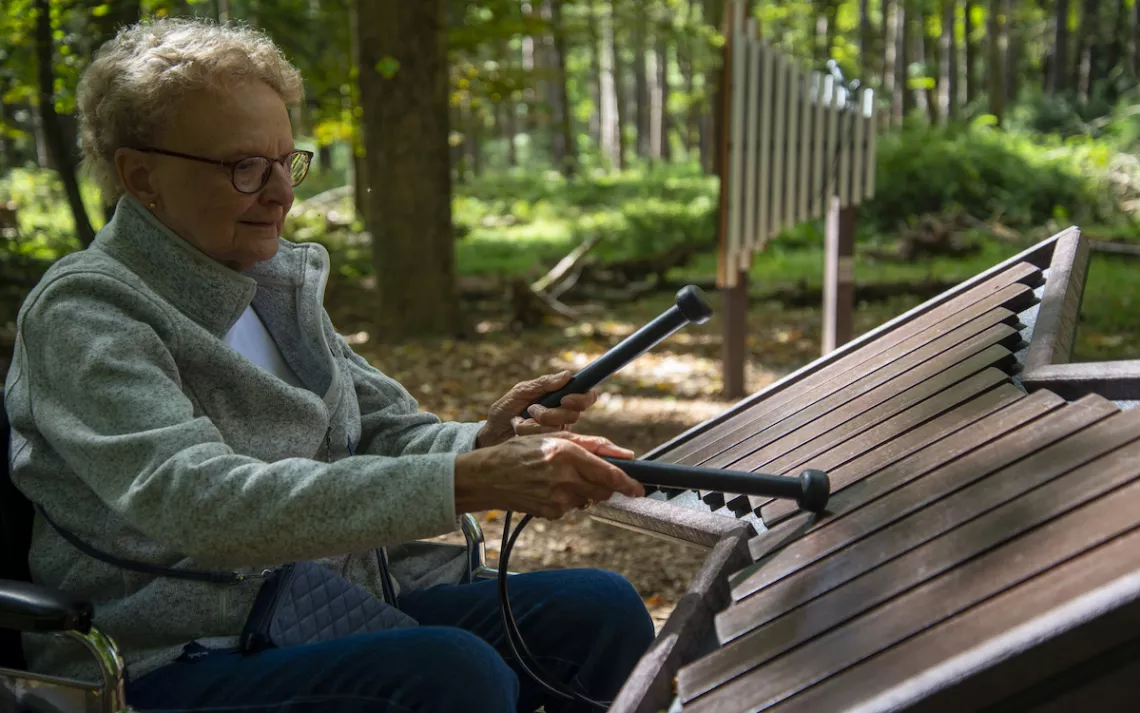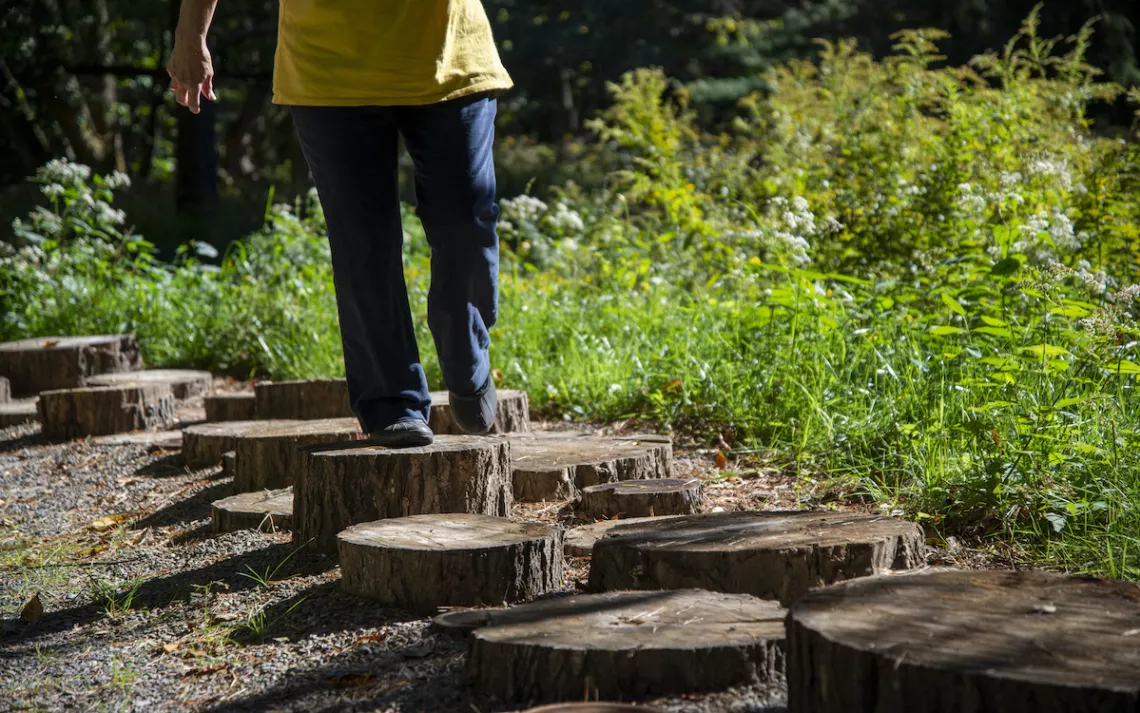The New York Trail Designed for Neurodivergent Adventurers
This inclusive space is the first of its kind in the US

Photos courtesy of Michael Grandeau, NYS Office of Parks, Recreation, and Historic Preservation photographer
A hiking trail in upstate New York is drawing praise for welcoming an underserved group of nature lovers: the neurodiverse community. The mile-long Autism Nature Trail, which opened in October 2021 at Letchworth State Park, was designed specifically for those whose brains work differently from the so-called neurotypical versions.
With eight stations at various intervals along the loop, the trail offers experiences from quiet engagement to active exploration and adventure. Founders believe the trail is the first autism-specific outdoor attraction anywhere in the United States—and one of the first trails in the world to be designed specifically for neurodivergent individuals.
“The [ANT] helps remove barriers to the outdoors,” wrote New York State parks commissioner Erik Kulleseid in an email. “The goal of the Autism Nature Trail is to provide a safe and inclusive space outdoors where all are welcome to experience the physical, emotional, and social benefits of outdoor recreation.”
The ANT was born from a conversation among friends, one of whom had a neurodivergent grandchild. Loren Penman, Gail Serventi, and the late Susan Herrnstein had long compared stories about the limited resources available to neurodivergent children in their lives. They wanted a place where individuals with autism and ADHD could feel welcome, no matter what—a nature trail for all. They called it the ANT, referring to themselves as the “ANT Aunts,” a nickname that stuck. In October 2014, the ANT Aunts started emailing neurodiversity experts, expanding their focus to include the broader community.
An early message went to Temple Grandin, a professor of animal science at Colorado State University who has spoken widely about her autism. Much to Penman’s surprise, Grandin wrote back.
“She offered us some critical advice, that we should make the trail a loop to provide visitors with a sense of security and to make signage frequent and consistent, so nobody would ever feel lost,” said Penman.
Next, Serventi assembled a 17-member, all-volunteer clinical advisory panel: speech pathologists, physical therapists, occupational therapists, special educators, and more. Finally, they sought designers to ensure the trail would be accessible for visitors in wheelchairs.
Jacquelyn Fede, an assistant research professor at the University of Rhode Island and codirector of the neurodivergent advocacy and consulting group Autism Level UP, served on the ANT design team and said that the eclectic advisory panel including neurodiverse individuals helped ensure the trail was truly welcoming.
“Anything designed for a population will be best designed by that population. They know their own needs and preferences,” said Fede, who is autistic. She added that the outdoors is particularly comfortable for many autistic people because “there are patterns and there is logic; it is everything artificial environments are not and more.”
The outdoors is particularly comfortable for many autistic people because “there are patterns and there is logic; it is everything artificial environments are not and more.”

Today, stone boulders along the trail help with wayfinding. Around the perimeter, eight spur trails lead hikers to experiences designed with different sensory inputs. The Reflection Knoll is a circle of rocks under a canopy of black cherry, white pine, ash, and sugar maple trees. At another station, wooden elements for running, jumping, climbing, and balancing engage physical touch. The Music Circle has a wheelchair-accessible stage, nature-inspired instruments, and two Alone Zones, where visitors with auditory and sensory needs can play away from background noise.
The Music Circle is a favorite spot for 27-year-old Kian an Chua of nearby Batavia, New York, who gravitates to this station on visits with his caregiver and family. “The [ANT] has a section of drums; you can hit them with hands or sticks they have too. Playing these makes him so happy,” said Allison Chua, his mother. “It’s so nice to know that after all these years of looking for places he can feel comfortable, we have such a great one right in our backyard.”
Penman explained that varied trail surfaces are also critical, as they can help individuals with sensory issues orient themselves. For example, the main trail is paved with stone dust, while the spur trails are composed chiefly of wood fiber.
“When you leave the main trail, it’s evident by the change of surface,” she said, adding that Grandin had suggested the design so users could opt into, or out of, each experience. “This detail is subtle, but for neurodivergent individuals, it makes a huge difference. These are the kinds of things that make this a nature trail for all.”
Fundraising remains a primary focus. The ANT Aunts have raised $3.5 million of an original $4 million goal and are working to establish an endowment of at least $2.3 million.
Another emphasis for the future is outreach. Brittany Johnson is the trail’s “sensory destination coordinator,” a job that includes educating local businesses about autism and other forms of neurodivergence. If the community understands how to accommodate neurodivergent visitors, Johnson reasons, that will extend and amplify the inclusive nature of the ANT.
Most of these efforts revolve around neurodiversity training. Johnson also provides businesses with tools such as picture menus, noise-canceling headphones, and fidgets. “This role has brought my life’s work full circle,” said Johnson, who is also a special education teacher in local schools. “I am now able to not only educate and provide opportunities for my students in school, but in their community as well.”
This type of wraparound approach has locals excited about the future. Penman and Serventi, both retired educators, said they hope the ANT serves as a model for similar projects across the country and around the world.
“Nature is the great unifier,” Serventi said. “If we can create spaces in nature that are inclusive for everyone, we can move to a place where neurotypical people can become more accepting of neurodivergent individuals, and more aware of the differences that make us special.”
 The Magazine of The Sierra Club
The Magazine of The Sierra Club



